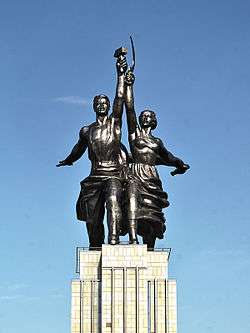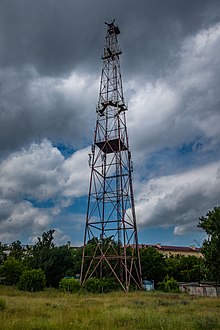Censorship in the Soviet Union
Censorship in the Soviet Union was pervasive and strictly enforced.
| Mass repression in the Soviet Union |
|---|
| Economic repression |
| Political repression |
| Ideological repression |
|
| Ethnic repression |
|
| This article is part of a series on the |
| Politics of the Soviet Union |
|---|
 |
|
Leadership |
|
Governance |
| Part of a series on the |
| Culture of the Soviet Union |
|---|
 |
| People |
| Languages |
| Traditions |
| Cuisine |
| Festivals |
|
Art |
| Literature |
|
Music and performing arts |
| Sport |
|
Monuments |
|
Symbols
|
|
| Part of a series on |
| Censorship by country |
|---|
 |
| Countries |
| See also |
Censorship was performed in two main directions:
- State secrets were handled by the General Directorate for the Protection of State Secrets in the Press (also known as Glavlit), which was in charge of censoring all publications and broadcasting for state secrets
- Censorship, in accordance with the official ideology and politics of the Communist Party was performed by several organizations:
- Goskomizdat censored all printed matter: fiction, poetry, etc.
- Goskino, in charge of cinema
- Gosteleradio, in charge of radio and television broadcasting
- The First Department in many agencies and institutions, such as the State Statistical Committee (Goskomstat), was responsible for assuring that state secrets and other sensitive information only reached authorized hands.
Destruction of printed matter
The Soviet government implemented mass destruction of pre-revolutionary and foreign books and journals from libraries. Only "special collections" (spetskhran), accessible by special permit granted by the KGB, contained old and politically incorrect material.[1] Towards the end of Soviet rule, perestroika led to loosened restrictions on information and publishing.
Soviet books and journals also disappeared from libraries according to changes in Soviet history. Often Soviet citizens preferred to destroy politically incorrect publications and photos because those connected to them frequently suffered persecution, such as its persecution of Christians.
After the arrest of Lavrentiy Beria in 1953, all subscribers to the second edition (1950–1958) of the Great Soviet Encyclopedia obtained a page to replace the one containing the Lavrentiy Beria article; the new page extended information on George Berkeley.
Soviet censorship of literature
Works of print such as the press, advertisements, product labels, and books were censored by Glavlit, an agency established on June 6, 1922, to safeguard top secret information from foreign entities. From 1932 until 1952, the promulgation of socialist realism was the target of Glavlit in bowdlerizing works of print, while anti-Westernization and nationalism were common tropes for that goal. To limit peasant revolts over collectivization, themes involving shortages of food were expunged. In the 1932 book Russia Washed in Blood, a Bolshevik's harrowing account of Moscow's devastation from the October Revolution contained the description, "frozen rotten potatoes, dogs eaten by people, children dying out, hunger," but was promptly deleted.[2] Also, excisions in the 1941 novel Cement were made by eliminating Gleb's spirited exclamation to English sailors: "Although we're poverty-stricken and are eating people on account of hunger, all the same we have Lenin."[2]
As peasant uprisings defined pre-World War II Soviet censorship, nationalism defined the period during the war. Defeats of the Red Army in literature were forbidden, as were depictions of trepidation in Soviet military characters. Pressure from the Pravda prompted authors like Alexander Alexandrovich Fadeyev to redact a section in The Young Guard where a child reads in the eyes of a dying Russian sailor the words "We are crushed."[3] Since Joseph Stalin regularly read Pravda, which was itself censored by Glavlit, it was wise for an author to obey Pravda’s advice.
With the start of the Cold War, a curse on anti-Westernization was proclaimed, mirroring the American Second Red Scare to some extent. For instance, in the 1950 edition of The Ordeal of Sevastopol, censors made over three hundred cuts,[4] screening the book's references to Frenchmen as "a people of very lively imagination", and the chivalrous treatments which the French gave to Russian prisoners—such as eating in the passenger's lounge and being given a hundred francs per month—were extracted from the text.[5] Historically, Russia has been technologically inferior to the West, which is demonstrated by Glavlit editing out a section of Sevastopol which enviously describes London's technological accomplishments in flattering detail. Religious intolerance and atheism was another goal of post-World War II censorship, and was an extension of anti-Westernization. In the children's novel Virgin Soil Upturned, references to God making mist out of tears shed by the poor and hungry were rescinded.[6]
The "Khrushchev Thaw", beginning in 1953 with Stalin's death, brought liberation of previously banned literature, and greater liberty to the authors writing during this time. Glavlit's authority to censor literature decreased after they became attached to the USSR Council of Ministers in 1953. The nascence of de-Stalinization—the government's remission of Stalin's policies—is evident by censors replacing his name in For the Power of the Soviets, with words like "the party," or "the Supreme Commander." Anti-Westernization was also suppressed, and in 1958 "Sevastopol," became divested of cuts meant to hide the West's technological advancement and Russia's backwardness. When Solzhenitsyn's One Day in the Life of Ivan Denisovich, a novel about a prisoner's brutal experience in the gulag, was released to the public in 1962, it was clear that socialist realism was disappearing. However, censorship was not completely absent from this era. Emmanuil Kazakevich's 1962 novel, Spring on the Oder, was posthumously injected in 1963 with descriptions of American bigotry, selfishness, and racism which was not in the novel originally.[7] These examples of anti-Westernization indicate that works were still expurgated for propaganda, but censorship still declined with Khrushchev's de-Stalinization.
Censorship of images
Repressed persons were routinely removed not only from texts, but also from photos, posters and paintings.
Soviet censorship of film
Censorship of film was commonplace since the USSR's inception. Beginning with the Russian Civil War (1917–1922), censoring film effectively advanced socialist realism, a mode of art production that positively portrays socialism and constituents of socialist nations. As propaganda tools against the masses—particularly the illiterate—themes of anti-Westernization and nationalism depicted socialist realism in films by negatively portraying elements of capitalist countries while positively depicting the Soviet Union. Elements of anti-Westernization included censoring religion and technological superiority, while signs of weakness in the Soviet military like lost battles or frightened soldiers were expurgated to further nationalistic goals. Film censorship peaked during the rule of Stalin (1941–1953).
Acting as the chief censor for films, Stalin was demanding meticulous revisions in a way befitting his interpretation, as if a co-author. One famous letter Stalin wrote to Alexander Dovzhenko pertained to The Great Citizen, a film about the Purge Trials. Stalin's letter made several intrusive revisions on the characters, props, and vital scenes such that the entire film needed restructuring.[8] More moderate cases were recorded, such as a picture by Ivan Pyryev, where Stalin only changed the title from Anka to The Party Card. However, movies which Stalin thought did not cohere with socialist realism were denied being released to the public; The Party Card was not such a film. This picture's screenplay was written during the time of a national campaign to renew individual party cards, and losing one amounted to a serious lack of Soviet discipline. Anka, the main character, has her card stolen by her lover, who is the surreptitious son of a kulak.[9]
Kulaks were farmers resisting Stalin's crop collectivization, and Anka's lover uses the party card for iniquitous purposes. In the final scene of the movie she confronts him at gunpoint and, after he ignominiously begs forgiveness, she has him arrested by the authorities. By vilifying kulaks, Stalin aimed to diminish public sympathy for them. Socialist realism is promoted since, at the end of the movie, her loyalty to the party takes precedence over her romantic feelings; therefore, Stalin approved its production. However, not all films earned his approval.
One example is the 1940 film, The Law of Life, which was retracted from cinemas after ten days because it negatively portrayed a Komsomol leader by depicting him as hypocritical and abusing his power. Stalin organized a military tribunal which castigated the scenarist Aleksandr Avdeenko, accusing him of inaccurate representations of Soviet reality. While nothing was said of the director, Avdeenko was jettisoned from the party. However, directors were not always spared, as in the case of Margarita Barskaia. Her film Father and Son features a factory director who prioritizes his work over educating his son, Boris. Portraying Boris as an unhappy child and the father—a war hero—as a slothful parent was regarded as slanderous by a film reviewer. After her movie was removed from cinemas she was arrested, and died in the gulag.[10]
While Glavlit censored literature, Stalin micro-managed the film industry. He made "recommendations" on what should be included, edited, or deleted entirely. If ignored, similar consequences to those that befell Margarita were meted out. However, while he was obsessed with films, Stalin was uneducated on film production. Due to this ignorance, Stalin thought of the director as a mere technician who carried out instructions. Therefore, he dictated that camera angles should not be shot from below, or above the actor, but always at eye level. Stalin's callowness over the importance of the director's work was of great benefit to the filmmakers since, "with few exceptions, they survived."[11]
The centrality of Stalin in film censorship lasted to his death in 1953, but the strictness of Soviet censorship did not survive him. Khrushchev succeeded Stalin as the USSR's Premier, and articulated de-Stalinization in his secret speech to the 20th Congress of the Communist Party of the Soviet Union. At this point, censorship finally began to diminish; this was known as the "Khrushchev Thaw." Film output grew to 20 pictures in 1953, 45 in 1954, and 66 in 1955.[12] Movies now introduced themes that were formerly considered taboo, like conflicted characters. In the 1959 film Ballad of a Soldier, Alyosha, the main character, experiences a conflict between his lover and his obligations to the military. The off-screen text at the end of the film reads, “He could have become a worker…grown wheat and adorned the earth with gardens. But all he managed in his short life was to become a soldier.”[13] While restrictions on film still pervaded during the “Khrushchev Thaw”, they were significantly fewer than under Stalin.
Translations
Translations of foreign publications were often produced in a truncated form, accompanied with extensive corrective footnotes. For example, in the Russian 1976 translation of Basil Liddell Hart's History of the Second World War pre-war purges of Red Army officers, secret protocol to the Molotov–Ribbentrop Pact, many details of the Winter War, occupation of Baltic states, Soviet occupation of Bessarabia and Northern Bukovina, Allied assistance to the Soviet Union during the war, many other Western Allies' efforts, the Soviet leadership's mistakes and failures, criticism of the Soviet Union, and other content were censored out.[14]
Control over information
All media in the Soviet Union was controlled by the state including television and radio broadcasting, newspaper, magazine, and book publishing. This was achieved by state ownership of all production facilities, thus making all those employed in media state employees. This extended to the fine arts including the theater, opera, and ballet. Art and music was controlled by ownership of distribution and performance venues.
Censorship was backed in cases where performances did not meet with the favor of the Soviet leadership, with newspaper campaigns against offending material and sanctions applied through party-controlled professional organizations.
In the case of book publishing, a manuscript had to pass censorship and the decision of a state owned publishing house to publish and distribute the book. Books which met with official favor, for example, the collected speeches of Leonid Brezhnev were printed in vast quantities while less favored literary material might be published in limited numbers and not distributed widely. [15]
Possession and use of copying machines was tightly controlled in order to hinder production and distribution of samizdat, illegal self-published books and magazines.[16] Possession of even a single samizdat manuscript such as a book by Andrei Sinyavsky was a serious crime which might involve a visit from the KGB. Another outlet for works which did not find favor with the authorities was publishing abroad.[16]
It was the practice of libraries in the Soviet Union to restrict access to back issues of journals and newspapers more than three years old.[16]
Jamming of foreign radio stations
Due to the appearance of foreign radio stations broadcasting in Russian territory and inaccessibility for censorship, as well as the appearance of a large number of shortwave receivers, massive jamming of these stations was applied in the USSR using high-power radio-electronic equipment. It continued for almost 60 years. The Soviet radio censorship network was the most powerful in the world.
All information related to radio jamming and usage of corresponding equipment was considered a state secret. On the eve of the 1980 Summer Olympics in Moscow, the Olympic Panorama magazine intended to publish a photo with a hardly noticeable jamming tower located in the Fili District. Despite the photo being of a public place, it was approved for publication only after the tower was cut from it.
The production of receivers with wavelengths shorter than 25 meters was also controlled. Receivers with those ranges were primarily exported and were sold very rarely within the country.
Circumvention of censorship
Samizdat, allegorical styles, smuggling, and tamizdat (publishing abroad) were used as methods of circumventing censorship.
For example, an underground library was functioning in Odessa from 1967 to 1982, which was used by around 2,000 readers.
Soviet dissidents were active fighters against censorship. Samizdat was the main method of information dissemination. Such organizations as the Moscow Helsinki Group and the Free Interprofessional Labor Union were also engaged in similar activities.
There were cases of literary hoaxes, where authors made up a translated source. Poet Vladimir Lifschitz, for instance, invented a British poet named James Clifford, who allegedly died in 1944 on the Western Front. Vladimir published poetry which he claimed was written by James Clifford, but which was actually his own work.
One more method was a so-called "dog method". According to this, one should include an obviously ridiculous and attention-drawing vivid episode in the work. As a result, minor nuances went unnoticed. In this manner, a movie named The Diamond Arm was saved after the director, Leonid Gaidai, intentionally included a nuclear explosion at the end of the film. The Goskino commission was horrified and requested that the explosion be removed. After resisting for a while, Gaidai removed the explosion and the rest of the film was left almost untouched.
One of the important information channels were anecdotes. Through this, folklore from people often express their critical attitude to authorities and communist ideology. Political anecdotes became widespread in the 60s and 70s.
See also
|
Other Eastern Bloc states:
|
|
References
- Kimmage (1988). "Open Stacks in a Closed Society? Glasnost in Soviet Libraries". American Libraries. 19 (7): 570–575. JSTOR 25631256.
- Ermolaev, Herman (1997). Censorship in Soviet Literature (1917-1991). Lanham u.a.: Rowman & Littlefield, Boston. 78.
- Ermolaev, Herman (1997). Censorship in Soviet Literature (1917-1991). Lanham u.a.: Rowman & Littlefield, Boston. 124.
- Thompson, Ewa M. (1991-01-01). The Search for Self-definition in Russian Literature. p. 25. ISBN 978-9027222138.
- Ermolaev, Herman (1997). Censorship in Soviet Literature (1917-1991). Lanham u.a.: Rowman & Littlefield, Boston. 109.
- Ermolaev, Herman (1997). Censorship in Soviet Literature (1917-1991). Lanham u.a.: Rowman & Littlefield, Boston. 137.
- Ermolaev, Herman (1997). Censorship in Soviet Literature (1917-1991). Lanham u.a.: Rowman & Littlefield, Boston. 167.
- Kenez, Peter (2001). Cinema and Soviet Society: From the Revolution to the Death of Stalin, I.B. Tauris Publishers. London and New York. Print.133.
- Kenez, Peter (2001). Cinema and Soviet Society: From the Revolution to the Death of Stalin, I.B. Tauris Publishers. London and New York. Print. 133.
- Kenez, Peter (2001). Cinema and Soviet Society: From the Revolution to the Death of Stalin, I.B. Tauris Publishers. London and New York. Print. 139.
- Kenez, Peter (2001). Cinema and Soviet Society: From the Revolution to the Death of Stalin, I.B. Tauris Publishers. London and New York. Print. 131.
- Zorkaya, Neya (1989). The Illustrated History of the Soviet Cinema, Hippocrene Books, New York. Print. 195.
- Zorkaya, Neya (1989). The Illustrated History of the Soviet Cinema, Hippocrene Books, New York. Print. 217.
- Lewis, B. E. (1977). Soviet Taboo. Review of Vtoraya Mirovaya Voina, History of the Second World War by B. Liddel Gart (Russian translation). Soviet Studies 29 (4), 603-606.
- De Villiers, Marq. (1992). Down the Volga : a journey through Mother Russia in a time of troubles (1st American ed.). New York: Viking. pp. 46–7. ISBN 0670843539. OCLC 24318763.
- Wettlin, Margaret (1992). Fifty Russian winters : an American woman's life in the Soviet Union. New York: Pharos Books. pp. 200, 308–9. ISBN 0886876540. OCLC 24668923.
External links
- Attacks on Intelligentsia: Censorship - from Library of Congress web site
- Censorship in the Soviet Union and its Cultural and Professional Results for Arts and Art Libraries
- Lewis, B. E. (1977). Soviet Taboo. Review of Vtoraya Mirovaya Voina, History of the Second World War by B. Liddel Gart (Russian translation). Soviet Studies 29 (4), 603-606.
- Venclova, Tomas (July 1978). "USSR: Stages of censorship". Index on Censorship. 7 (4): 61–62. doi:10.1080/03064227808532817.
- Fireside, Harvey (October 2001). "Psychiatry and censorship in the USSR, 1950s–1980s". Index on Censorship. 30 (4): 211–212. doi:10.1080/03064220108536997.
- Stelmakh, Valeria (Winter 2001). "Reading in the context of censorship in the Soviet Union". Libraries & Culture. 36 (1): 143–151. doi:10.1353/lac.2001.0022. JSTOR 25548897.

